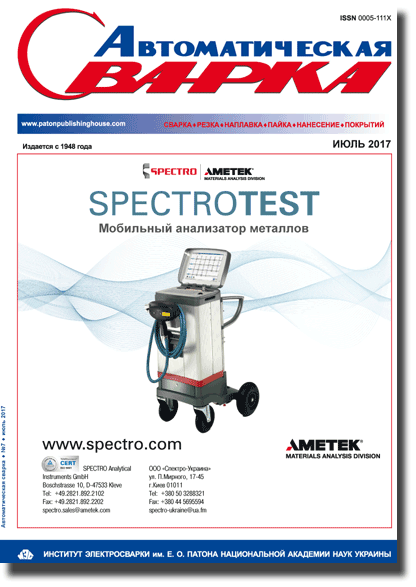| 2017 №07 (09) |
DOI of Article 10.15407/as2017.07.01 |
2017 №07 (02) |

Avtomaticheskaya Svarka (Automatic Welding), #7, 2017, pp. 3-7
Synthesis of structure of system for self-regulation of electrode melting rate
G.A. Tsybulkin
E.O. Paton Electric Welding Institute, NASU 11 Kazimir Malevich Str., 03680, Kiev, Ukraine. E-mail: office@paton.kiev.ua
Abstract
In automation of consumable electrode arc welding it is necessary to have a clear knowledge about the structure of system for a self-regulation of the electrode melting rate. In the given work a general structure of this system is constructed on the basis of analytical description of dynamic processes, proceeding in the welding circuit. A simple structure analysis allows easy obtaining the necessary characteristics of the self-regulation system, including accuracy in a steady mode and time of optimizing the effect of disturbances. Criteria are suggested, that allow selecting those parameters of welding processes from the admissible values, which provide the desirable quick-response of the self-regulation system. Results of comparison of quick-response estimates, obtained by using these criteria, with results of computer modeling, are given. 21 Ref., 5 Figures.
Keywords: robotic arc welding, consumable electrode, structure of self-regulation system, evaluation of accuracy and quick-response of system
Received: 11.05.17
Published: 01.09.17
References
- Tsybulkin, V.N. (1978) Theory of control and biosystems. Analysis of conservation properties. Moscow: Nauka.
- Albegov, E.V., Butenko, D.V., Butenko, L.N. (2014) Homeostatics: concept modeling of structured stable systems: Monography. Moscow: Natural Sci. Acad.
- Paton, B.E. (1952) Self-regulation in consumable electrode welding. Svarka, 1, 38–45.
- Lenivkin, V.A., Dyurgerov, N.G., Sagirov, Kh.N. (1989) Technological properties of welding arc in shielded gases. Moscow: Mashinostroenie.
- Leskov, G.I. (1970) Electric welding arc. Moscow: Mashinostroenie.
- Tsybulkin, G.A. (2014) Adaptive control in arc welding: Monography. Kiev: Stal.
- Lebedev, A.V. (1978) Influence of heat evolution in electrode stickout on process of self-regulation. Svarka, 7, 10–15.
- (1986) Automation of welding processes. Ed. by V.K. Lebedev. Kiev: Vyshcha Shkola.
- Paton, B.E., Lebedev, V.K. (1966) Electric equipment for arc and slag welding. Moscow: Mashinostroenie.
- Sudnik, V.A., Erofeev, V.A., Logvinov, R.V. (1999) Examination of stability of the consumable electrode shielded-gas arc welding. In: Computer technologies in joining of materials: Transact. Tula: TSU, 110–120.
- Pan, J. (2003) Arc welding control. Wood head Publish. LTD and CRC LLC.
- Makarov, I.M., Mensky, B.M. (1977) Linear automatic systems ( elements of theory, methods of calculation and reference document): Manual for inst. of higher education. Moscow: Mashinostroenie.
- Dorf, R., Bishop, R. (2002) Modern control systems. Moscow: Laboratory of basic knowledges.
- (1988) Theory of control. Terminology, Issue 107. Moscow: Nauka.
- Tsybulkin, G.A. (2005) Influence of frequency properties of the welding circuit on current parameters in pulsed-arc welding processes. The Paton Welding J., 10, 9–13.
- Voropaj, N.M., Ilyushenko, V.M., Lankin, Yu.N. (1999) Peculiarities of pulsed-arc welding with synergic control of mode parameters (Review). Svarka, 6, 26–32.
- Paton, B.E., Shejko, P.P., Zhernosekov, A.M. et al. (2003) Stabilization of the process of consumable electrode pulse-arc welding. The Paton Welding J., 8, 2–5.
- Saraev, Yu.N. (2002) Adaptive pulsed-arc methods of mechanized welding in construction of main pipelines. Proizvodstvo, 1, 4–11.
- Tsybulkin, G.A. (2016) Effect of parameters of welding circuit on formation of welding current pulses. The Paton Welding J., 9, 14–17. https://doi.org/10.15407/tpwj2016.09.03
- Lebedev, V.K., Uzilevsky, Yu.A., Savich, I.M. et al. (1980) Analysis of possibility of adjustment by self-regulation system of typical disturbances on arc length in mechanized underwater welding: Underwater welding and cutting. by A.E. Asnis. Kiev: PWI, 10–23.
- Korinets, I.F. (1995) Mathematical model of electrode wire melting in arc welding. Svarka, 10, 39–43.
The cost of subscription/purchase order journals or individual articles
| Journal/Currency | Annual Set | 1 issue printed |
1 issue |
one article |
| TPWJ/USD | 384 $ | 32 $ | 26 $ | 13 $ |
| TPWJ/EUR | 348 € | 29 € | 24 € | 12 € |
| TPWJ/UAH | 7200 UAH | 600 UAH | 600 UAH | 280 UAH |
| AS/UAH | 1800 UAH | 300 UAH | 300 UAH | 150 UAH |
| AS/USD | 192 $ | 32 $ | 26 $ | 13 $ |
| AS/EUR | 180 € | 30 € | 25 € | 12 € |
| SEM/UAH | 1200 UAH | 300 UAH | 300 UAH | 150 UAH |
| SEM/USD | 128 $ | 32 $ | 26 $ | 13 $ |
| SEM/EUR | 120 € | 30 € | 25 € | 12 € |
| TDNK/UAH | 1200 UAH | 300 UAH | 300 UAH | 150 UAH |
| TDNK/USD | 128 $ | 32 $ | 26 $ | 13 $ |
| TDNK/EUR | 120 € | 30 € | 25 € | 15 € |
AS = «Automatic Welding» - 6 issues per year;
TPWJ = «PATON WELDING JOURNAL» - 12 issues per year;
SEM = «Electrometallurgy Today» - 4 issues per year;
TDNK = «Technical Diagnostics and Non-Destructive Testing» - 4 issues per year.





